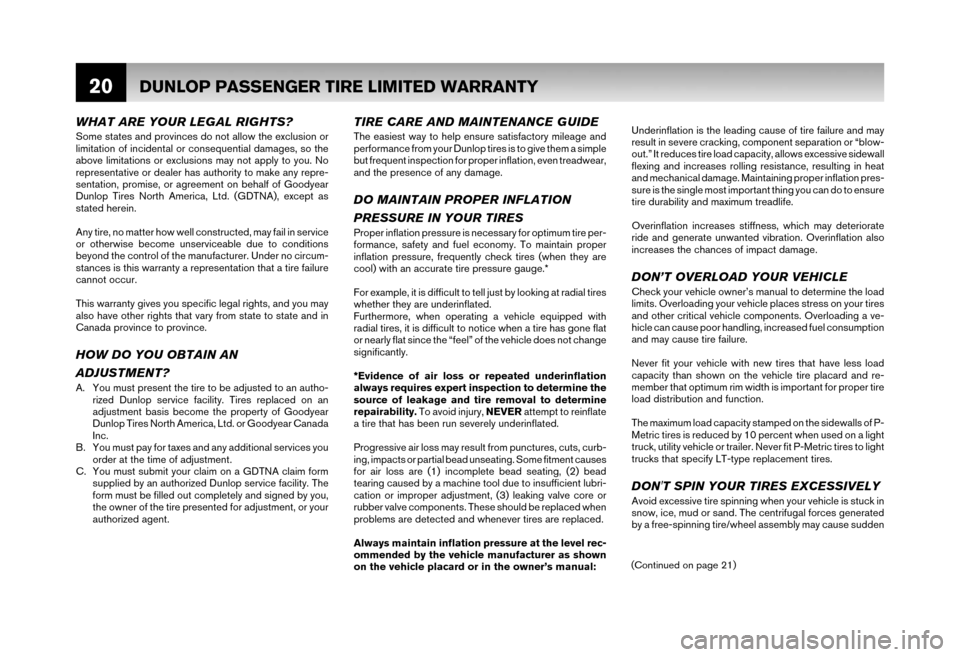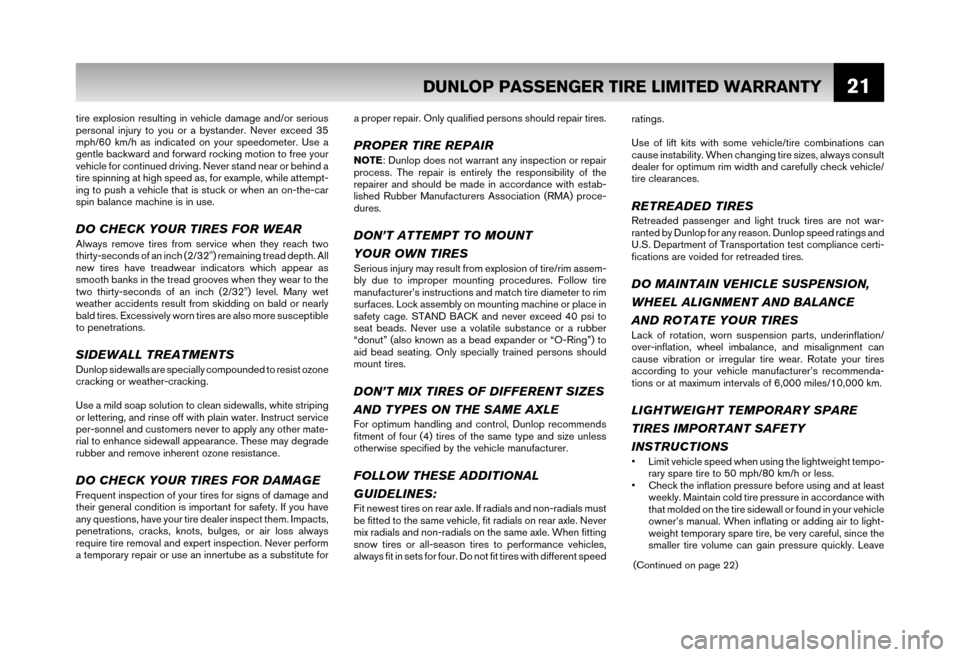2006 NISSAN PATHFINDER width
[x] Cancel search: widthPage 25 of 55

20DUNLOP PASSENGER TIRE LIMITED WARRANTY
WHAT ARE YOUR LEGAL RIGHTS?
Some states and provinces do not allow the exclusion or
limitation of incidental or consequential damages, so the
above limitations or exclusions may not apply to you. No
representative or dealer has authority to make any repre-
sentation, promise, or agreement on behalf of Goodyear
Dunlop Tires North America, Ltd. (GDTNA), except as
stated herein.
Any tire, no matter how well constructed, may fail in service
or otherwise become unserviceable due to conditions
beyond the control of the manufacturer. Under no circum-
stances is this warranty a representation that a tire failure
cannot occur.
This warranty gives you specific legal rights, and you may
also have other rights that vary from state to state and in
Canada province to province.
HOW DO YOU OBTAIN AN
ADJUSTMENT?
A. You must present the tire to be adjusted to an autho- rized Dunlop service facility. Tires replaced on an
adjustment basis become the property of Goodyear
Dunlop Tires North America, Ltd. or Goodyear Canada
Inc.
B. You must pay for taxes and any additional services you order at the time of adjustment.
C. You must submit your claim on a GDTNA claim form supplied by an authorized Dunlop service facility. The
form must be filled out completely and signed by you,
the owner of the tire presented for adjustment, or your
authorized agent.
TIRE CARE AND MAINTENANCE GUIDE
The easiest way to help ensure satisfactory mileage and
performance from your Dunlop tires is to give them a simple
but frequent inspection for proper inflation, even treadwear,
and the presence of any damage.
DO MAINTAIN PROPER INFLATION
PRESSURE IN YOUR TIRES
Proper inflation pressure is necessary for optimum tire per-
formance, safety and fuel economy. To maintain proper
inflation pressure, frequently check tires (when they are
cool) with an accurate tire pressure gauge.*
For example, it is difficult to tell just by looking at radial tires
whether they are underinflated.
Furthermore, when operating a vehicle equipped with
radial tires, it is difficult to notice when a tire has gone flat
or nearly flat since the “feel” of the vehicle does not change
significantly.
*Evidence of air loss or repeated underinflation
always requires expert inspection to determine the
source of leakage and tire removal to determine
repairability. To avoid injury, NEVER attempt to reinflate
a tire that has been run severely underinflated.
Progressive air loss may result from punctures, cuts, curb-
ing, impacts or partial bead unseating. Some fitment causes
for air loss are (1) incomplete bead seating, (2) bead
tearing caused by a machine tool due to insufficient lubri-
cation or improper adjustment, (3) leaking valve core or
rubber valve components. These should be replaced when
problems are detected and whenever tires are replaced.
Always maintain inflation pressure at the level rec-
ommended by the vehicle manufacturer as shown
on the vehicle placard or in the owner’s manual: Underinflation is the leading cause of tire failure and may
result in severe cracking, component separation or “blow-
out.” It reduces tire load capacity, allows excessive sidewall
flexing and increases rolling resistance, resulting in heat
and mechanical damage. Maintaining proper inflation pres-
sure is the single most important thing you can do to ensure
tire durability and maximum treadlife.
Overinflation increases stiffness, which may deteriorate
ride and generate unwanted vibration. Overinflation also
increases the chances of impact damage.
DON’T OVERLOAD YOUR VEHICLECheck your vehicle owner’s manual to determine the load
limits. Overloading your vehicle places stress on your tires
and other critical vehicle components. Overloading a ve-
hicle can cause poor handling, increased fuel consumption
and may cause tire failure.
Never fit your vehicle with new tires that have less load
capacity than shown on the vehicle tire placard and re-
member that optimum rim width is important for proper tire
load distribution and function.
The maximum load capacity stamped on the sidewalls of P-
Metric tires is reduced by 10 percent when used on a light
truck, utility vehicle or trailer. Never fit P-Metric tires to light
trucks that specify LT-type replacement tires.
DON'T SPIN YOUR TIRES EXCESSIVELY
Avoid excessive tire spinning when your vehicle is stuck in
snow, ice, mud or sand. The centrifugal forces generated
by a free-spinning tire/wheel assembly may cause sudden
(Continued on page 21)
Page 26 of 55

21
tire explosion resulting in vehicle damage and/or serious
personal injury to you or a bystander. Never exceed 35
mph/60 km/h as indicated on your speedometer. Use a
gentle backward and forward rocking motion to free your
vehicle for continued driving. Never stand near or behind a
tire spinning at high speed as, for example, while attempt-
ing to push a vehicle that is stuck or when an on-the-car
spin balance machine is in use.
DO CHECK YOUR TIRES FOR WEAR
Always remove tires from service when they reach two
thirty-seconds of an inch (2/32") remaining tread depth. All
new tires have treadwear indicators which appear as
smooth banks in the tread grooves when they wear to the
two thirty-seconds of an inch (2/32") level. Many wet
weather accidents result from skidding on bald or nearly
bald tires. Excessively worn tires are also more susceptible
to penetrations.
SIDEWALL TREATMENTSDunlop sidewalls are specially compounded to resist ozone
cracking or weather-cracking.
Use a mild soap solution to clean sidewalls, white striping
or lettering, and rinse off with plain water. Instruct service
per-sonnel and customers never to apply any other mate-
rial to enhance sidewall appearance. These may degrade
rubber and remove inherent ozone resistance.
DO CHECK YOUR TIRES FOR DAMAGEFrequent inspection of your tires for signs of damage and
their general condition is important for safety. If you have
any questions, have your tire dealer inspect them. Impacts,
penetrations, cracks, knots, bulges, or air loss always
require tire removal and expert inspection. Never perform
a temporary repair or use an innertube as a substitute for a proper repair. Only qualified persons should repair tires.
PROPER TIRE REPAIRNOTE
: Dunlop does not warrant any inspection or repair
process. The repair is entirely the responsibility of the
repairer and should be made in accordance with estab-
lished Rubber Manufacturers Association (RMA) proce-
dures.
DON’T ATTEMPT TO MOUNT
YOUR OWN TIRES
Serious injury may result from explosion of tire/rim assem-
bly due to improper mounting procedures. Follow tire
manufacturer’s instructions and match tire diameter to rim
surfaces. Lock assembly on mounting machine or place in
safety cage. STAND BACK and never exceed 40 psi to
seat beads. Never use a volatile substance or a rubber
“donut” (also known as a bead expander or “O-Ring”) to
aid bead seating. Only specially trained persons should
mount tires.
DON’T MIX TIRES OF DIFFERENT SIZES
AND TYPES ON THE SAME AXLE
For optimum handling and control, Dunlop recommends
fitment of four (4) tires of the same type and size unless
otherwise specified by the vehicle manufacturer.
FOLLOW THESE ADDITIONAL
GUIDELINES:
Fit newest tires on rear axle. If radials and non-radials must
be fitted to the same vehicle, fit radials on rear axle. Never
mix radials and non-radials on the same axle. When fitting
snow tires or all-season tires to performance vehicles,
always fit in sets for four. Do not fit tires with different speed ratings.
Use of lift kits with some vehicle/tire combinations can
cause instability. When changing tire sizes, always consult
dealer for optimum rim width and carefully check vehicle/
tire clearances.
RETREADED TIRESRetreaded passenger and light truck tires are not war-
ranted by Dunlop for any reason. Dunlop speed ratings and
U.S. Department of Transportation test compliance certi-
fications are voided for retreaded tires.
DO MAINTAIN VEHICLE SUSPENSION,
WHEEL ALIGNMENT AND BALANCE
AND ROTATE YOUR TIRES
Lack of rotation, worn suspension parts, underinflation/
over-inflation, wheel imbalance, and misalignment can
cause vibration or irregular tire wear. Rotate your tires
according to your vehicle manufacturer’s recommenda-
tions or at maximum intervals of 6,000 miles/10,000 km.
LIGHTWEIGHT TEMPORARY SPARE
TIRES IMPORTANT SAFETY
INSTRUCTIONS
• Limit vehicle speed when using the lightweight tempo-
rary spare tire to 50 mph/80 km/h or less.
• Check the inflation pressure before using and at least weekly. Maintain cold tire pressure in accordance with
that molded on the tire sidewall or found in your vehicle
owner’s manual. When inflating or adding air to light-
weight temporary spare tire, be very careful, since the
smaller tire volume can gain pressure quickly. Leave
DUNLOP PASSENGER TIRE LIMITED WARRANTY
(Continued on page 22)